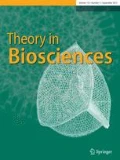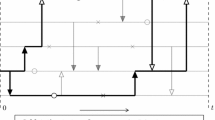Abstract
Fundamental properties of macroscopic gene-mating dynamic evolutionary systems are investigated. A model is studied to describe a large class of systems within population genetics. We focus on a single locus, any number of alleles in a two-gender dioecious population. Our governing equations are time-dependent continuous differential equations labeled by a set of parameters, where each parameter stands for a population percentage carrying certain common genotypes. The full parameter space consists of all allowed parameters of these genotype frequencies. Our equations are uniquely derived from four fundamental assumptions within any population: (1) a closed system; (2) average-and-random mating process (mean-field behavior); (3) Mendelian inheritance; and (4) exponential growth and exponential death. Even though our equations are nonlinear with time-evolutionary dynamics, we have obtained an exact analytic time-dependent solution and an exactly solvable model. Our findings are summarized from phenomenological and mathematical viewpoints. From the phenomenological viewpoint, any initial parameter of genotype frequencies of a closed system will eventually approach a stable fixed point. Under time evolution, we show (1) the monotonic behavior of genotype frequencies, (2) any genotype or allele that appears in the population will never become extinct, (3) the Hardy–Weinberg law and (4) the global stability without chaos in the parameter space. To demonstrate the experimental evidence for our theory, as an example, we show a mapping from the data of blood type genotype frequencies of world ethnic groups to our stable fixed-point solutions. From the mathematical viewpoint, our highly symmetric governing equations result in continuous global stable equilibrium solutions: these solutions altogether consist of a continuous curved manifold as a subspace of the whole parameter space of genotype frequencies. This fixed-point manifold is a global stable attractor known as the Hardy–Weinberg manifold, attracting any initial point in any Euclidean fiber bounded within the genotype frequency space to the fixed point where this fiber is attached. The stable base manifold and its attached fibers form a fiber bundle, which fills in the whole genotype frequency space completely. We can define the genetic distance of two populations as their geodesic distance on the equilibrium manifold. In addition, the modification of our theory under the process of natural selection and mutation is addressed.















Similar content being viewed by others
Notes
This model presented here is originated from an independent thought of the first author during his undergrad freshman year. The governing equations and model are derived in 2003. Substantial work is completed, and exact solutions are found in 2006. The manuscript presented here is a late update of our 2006’s work aiming to contribute to the academic literature.
For biologists or physicists who are familiar with the renormalization group procedure, the linear stability analysis here is simply finding the relevancy of small perturbations. For any eigenvalue equal to 0, the perturbation is marginal. For any eigenvalue smaller than 0, the perturbation is irrelevant, namely stable against perturbations. For any eigenvalue larger than 0, the perturbation is relevant, namely unstable against perturbations. See, for instance, Mehran (2007).
The fiber is bounded by the whole simplex of genotype frequency space, which has all coordinates of genotype frequency bounded from 0 to 1. Also, the sum of all genotype frequencies is 1. The Euclidean fiber is meant to emphasize that the fiber is straight as a Euclidean submanifold with Cartesian coordinates, instead of a curved Riemannian curved fiber/submanifold. When we refer to Euclidean fiber, we always mean the fiber bounded within the constrained genotype frequency space (within the constrained simplex).
References
Akin E, Szucs JM (1994) Approaches to the Hardy–Weinberg manifold. J Math Biol 32(7):633–643
Antonelli PL, Strobeck C (1977) The geometry of random drift I. Stochastic distance and diffusion. Adv Appl Probab 9:238
Antonelli PL, Chapin J, Lathrop GM, Morgan K (1977a) The geometry of random drift II. The symmetry of random genetic drift. Adv Appl Probab 9:250
Antonelli PL, Morgan K, Lathrop GM (1977a) The geometry of random drift III. Recombination and diffusion. Adv Appl Probab 9:260
Antonelli PL, Morgan K, Lathrop GM (1977c) The geometry of random drift IV. Random time substitutions and stationary densities. Adv Appl Probab 10:563
Cavalli-Sforza LL, Edwards AW (1967) Phylogenetic analysis: models and estimation procedures. Evolution 21:550
Chung M-H, Lee SP, Kim CK, Nahm K (1997) Fractional populations of blood groups. Phys Rev E 56:865
Crow JF, Kimura M (1970) An introduction to population genetics theory. Harper and Row, New York
Darwin C (1859) On the origin of species. John Murray, London
Dogan I, Dogan N (2016) Genetic distance measures. Turk Klinikleri J Biostat 8:87
Edwards AWF (2000) Foundations of mathematical genetics, 2nd edn. Cambridge University Press, Cambridge
Ewens WJ (2004) Mathematical population genetics, 2nd edn. Springer, Berlin
Fisher RA (1930) The genetical theory of natural selection. Clarendon Press, Oxford
Hardy GH (1908) Mendelian proportions in a mixed population. Science 28:49–50
Hofbauer J, Sigmund K (1988) The theory of evolution and dynamical systems: mathematical aspects of selection. London mathematical society student texts, vol 7. Cambridge University Press, Cambridge (translated from the German)
Mehran K (2007) Statistical physics of fields. Cambridge University Press, Cambridge
Mendel G (1865) Versuche über Plflanzenhybriden (Experiments in Plant Hybridization). Verhandlungen des naturforschenden Vereines in Brünn, Bd. IV für das Jahr, Abhandlungen, 37
Nagylaki T, Crow JF (1974) Continuous selective models. Theor Popul Biol 5:257
Nei M (1972) Genetic distance between populations. Am Nat 106:283
Reynolds J, Weir BS, Cockerham CC (1983) Estimation of the coancestry coefficient: basis for a short-term genetic distance. Genetics 105:767
Waltman P (1983) Competition models in population biology. Society for Industrial and Applied Mathematics, Philadelphia
Wang JC (2015) Gene-mating dynamic evolution theory II: global stability of N-gender-mating polyploid systems. Theory Biosci. https://doi.org/10.1007/s12064-020-00308-4
Wang J et al. Gene-mating dynamic evolution theory III: exactly solvable many-body Boltzmann equation generalization with continuous variables (in preparation)
Weinberg W (1908) Uber den Nachweis der Vererbung beim Menschen. Jahreshefte des Verein für vaterländische Naturkunde in Württemberg 64:368–382
Wright S (1921) Systems of mating. Genetics 6:111–178
Wright S (1931) Evolution in Mendelian populations. Genetics 16(2):97–159
Acknowledgements
JW would like to thank Mehran Kardar and Leonid Mirny for showing great interests and encouragements and giving comments. We thank Jeremy England, Hsien-Ching Kao and Matthew Pinson for comments on the manuscript. JW wishes to thank Yih-Yuh Chen and Ning-Ning Pang for comments in 2006 and thank Sze-Bi Hsu for introducing the reference Waltman (1983) in 2007 and mentioning the alternative approach: Hirsch’s monotone flow, for proving the global stability (our independent proof is in “General gene-mating evolution model and theory” section (1)). JW thanks Mehran Kardar, Patrick Lee and Xiao-Gang Wen for encouraging posting the paper. JW is supported by NSF Grant No. DMR-1005541, NSFC 11074140, NSFC 11274192, the BMO Financial Group and the John Templeton Foundation. Research at Perimeter Institute is supported by the Government of Canada through Industry Canada and by the Province of Ontario through the Ministry of Research. JW acknowledges the NSF Grant PHY-1606531. This work is also supported by NSF Grant DMS-1607871 “Analysis, Geometry and Mathematical Physics” and Center for Mathematical Sciences and Applications at Harvard University. JWC is supported in part by the MOST, NTU-CTS and the NTU-CASTS of R.O.C.
Author information
Authors and Affiliations
Corresponding author
Additional information
Publisher's Note
Springer Nature remains neutral with regard to jurisdictional claims in published maps and institutional affiliations.
Rights and permissions
About this article
Cite this article
Wang, J.C., Chen, JW. Gene-mating dynamic evolution theory: fundamental assumptions, exactly solvable models and analytic solutions. Theory Biosci. 139, 105–134 (2020). https://doi.org/10.1007/s12064-020-00309-3
Received:
Accepted:
Published:
Issue Date:
DOI: https://doi.org/10.1007/s12064-020-00309-3



